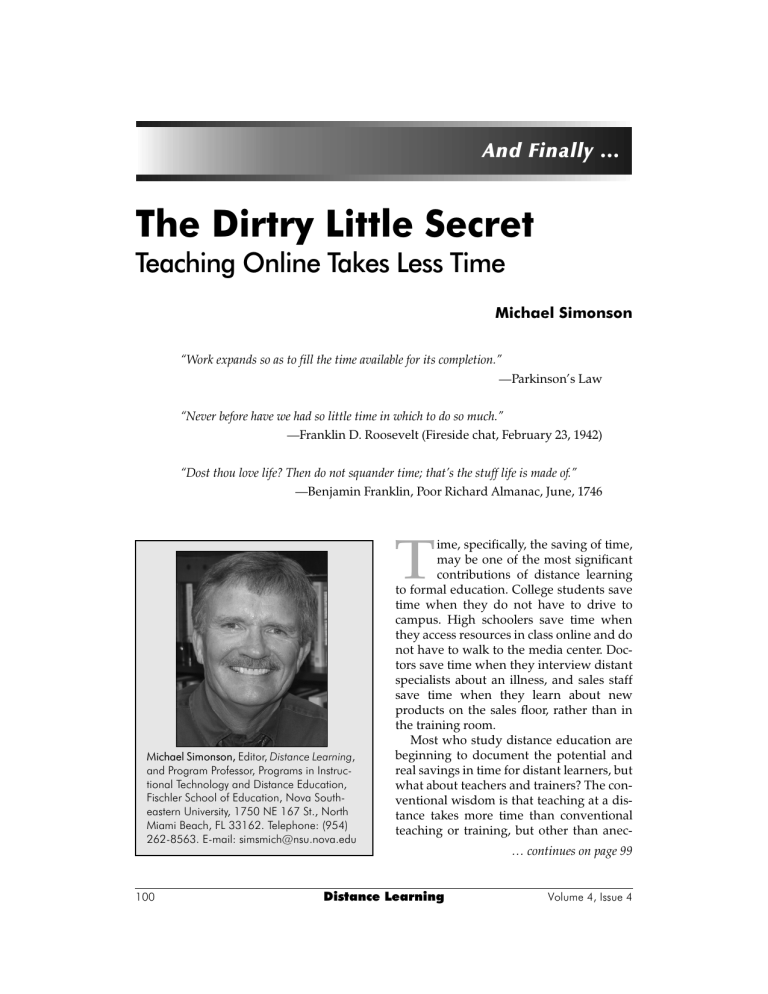Time Teaching Online: A Dirty Little Secret?

And Finally …
The Dirtry Little Secret
Teaching Online Takes Less Time
Michael Simonson
100
“Work expands so as to fill the time available for its completion.”
—Parkinson’s Law
“Never before have we had so little time in which to do so much.”
—Franklin D. Roosevelt (Fireside chat, February 23, 1942)
“Dost thou love life? Then do not squander time; that’s the stuff life is made of.”
—Benjamin Franklin, Poor Richard Almanac, June, 1746
Michael Simonson, Editor, Distance Learning , and Program Professor, Programs in Instructional Technology and Distance Education,
Fischler School of Education, Nova Southeastern University, 1750 NE 167 St., North
Miami Beach, FL 33162. Telephone: (954)
262-8563. E-mail: simsmich@nsu.nova.edu
T ime, specifically, the saving of time, may be one of the most significant contributions of distance learning to formal education. College students save time when they do not have to drive to campus. High schoolers save time when they access resources in class online and do not have to walk to the media center. Doctors save time when they interview distant specialists about an illness, and sales staff save time when they learn about new products on the sales floor, rather than in the training room.
Most who study distance education are beginning to document the potential and real savings in time for distant learners, but what about teachers and trainers? The conventional wisdom is that teaching at a distance takes more time than conventional teaching or training, but other than anec-
… continues on page 99
Distance Learning
Volume 4, Issue 4
And Finally … continued from page 100 dotal reports, where is the evidence to support this “wisdom”?
For example, let’s talk about the college course. According to the century-old standard of the course unit, sometimes called the Carnegie Unit, a one-credit course should have 750 minutes of instruction by a teacher to students in a classroom. This equates to fifteen 50-minute classes.
A three-credit class would have 2,250 minutes of classroom instruction, or fortyfive 50-minute classes often scheduled over a 15-week semester—three classes each week for 15 weeks. Typically, a student would be expected to spend 2 hours outside of class for every hour in the classroom—time spent studying or completing assignments.
What about instructors? Well, if students are in the classroom for forty-five 50minute sessions, the instructor probably is also. And, most agree that for every hour the college professor is in class he or she probably needs to spend 2 hours preparing and grading, so teacher and student time required to complete a typical college course is roughly equivalent.
Obviously, in a distance-delivered course, instructors do not attend a traditional class—there often is no formal class, especially in an asynchronous course.
Thus, instructor time can be reallocated from presenting to preparing, from lecturing to posting, and from explaining to interacting.
Does this change really happen? In some cases, possibly not, since there is a small but growing number of online instructors who teach asynchronous courses who are reporting that they need to allocate less time to teaching online to accomplish an equivalent level of involvement as they contributed to their traditional classes. As a matter of fact, a rule of thumb has been proposed—for every 10% of the content of a class that is converted from face-to-face instruction there is a 5% saving in instructor time, up to a total possible saving of 25%. Thus, for an experienced instructor, teaching an online course that he or she has taught several times, there is a potential saving of about 30 hours for a typical three-credit college course.
Obviously, this “dirty little secret” needs to be studied carefully and in a scientifically appropriate manner—the field needs research dealing with instructor time.
And finally, as Victor Hugo said in his
Histoire d’un Crime (1852), “An invasion of armies can be resisted, but not an idea whose time has come.”
Volume 4, Issue 4
Distance Learning
99






